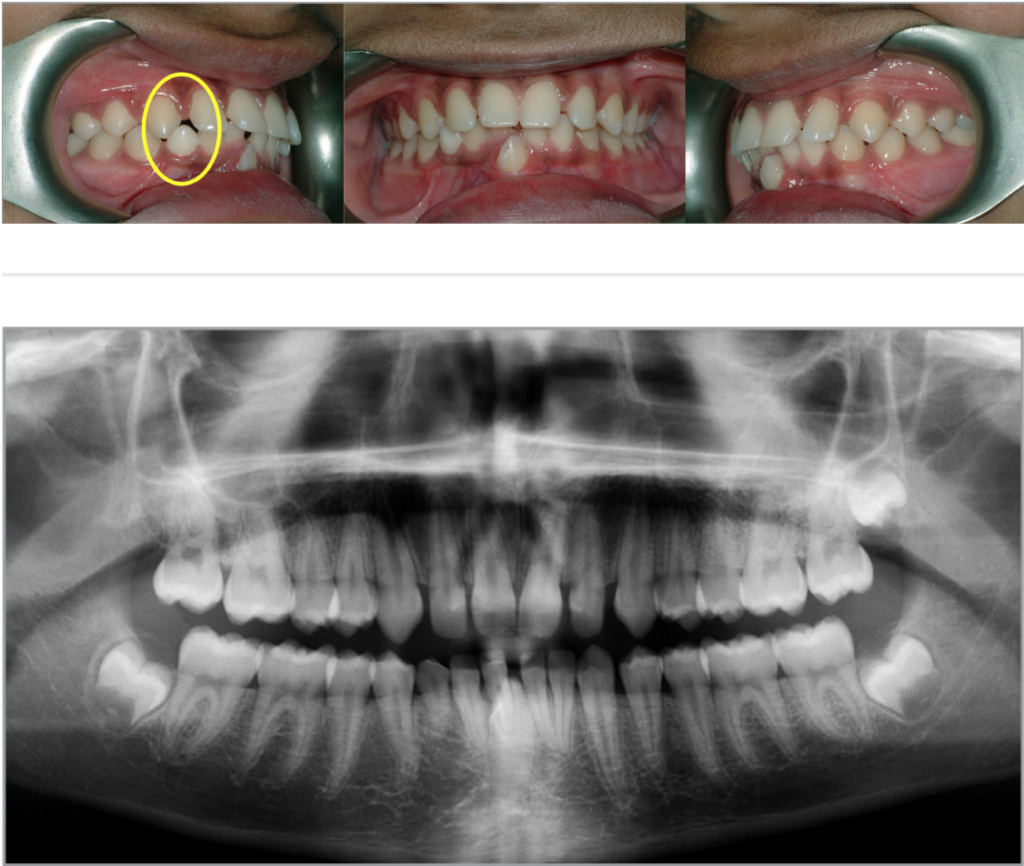The following presentation is the first part of our case series on the management of ectopic eruption of teeth.
Part 1
As we’ve discovered in our previous article, autotransplantation can be a viable means of replacing teeth. This procedure, however, requires a very technique sensitive protocol and management by means of multidisciplinary team and implementation of unconventional methods of treatment, including some novel techniques not taught in dental school nor readily reported in the literature.
Dr. Kulkarni and Lee report on a case of 14-year-old patient who presented to clinic with transmigrated right mandibular canine ectopically erupting in the midline of the mandible. Such incidence is rare, reported 0.1-0.34% in the literature. Therefore, management of such a case requires the clinician to think outside the box.
Pre-Op:

CC: Esthetic concern of mandibular canine
RMH: Non contributory dental, medical and familial history
IOE:
-Transmigration of right mandibular canine to midline
-Retained primary right canine
-Class 1 occlusion with moderate spacing
-50% overbite, 4mm overjet
-Normal pulp vitality
Radiographic Exam:
-Radiographic exam revealed
-Ectopic permanent mandibular canine located in the midline between the mandibular central incisors
-Normal periapical status noted
Treatment Options:
- Orthodontic alignment and subsequent restorative recontouring
- Surgical transplantation w/ or w/o endodontics
- Extraction, space maintenance and subsequent implant placement upon maturity
- Monitoring without intervention

Treatment Protocol:
- Bracketing of mandibular arch except primary right canine in achieving orthodontic space gaining in order to accommodate the permanent canine
- After two months of orthodontics, surgical transplantation initiated
- Prophylaxis and chlorohexidine rinse prior to extraction
- Buccal and lingual flap incisions made and recipient site prepared with implant drill to approximate the size and shape of permanent canine
- Atraumatic extraction initiated without the use of elevators avoiding contact with root and maintaining PDL structure intact
- Transmigrant canine transplanted into recipient socket with extra oral time of less than 30 seconds
- Dynagraft demineralized bone matrix gel injected into socket, hemostasis obtained and 3-0 chromic gut sutures placed
- Light orthodontic wire passively adapted transplanted tooth with neighboring for stabilization, transplanted tooth was left out of occlusion
- Post op included soft diet, gentle hygiene of transplanted tooth, and week prescription of 500mg Amoxicillin
- Excellent healing noted in both surgical sites a week following procedure
- Orthodontics initiated after soft tissue healing of 14 days.

Final Thoughts
Autotransplantation can be a viable option in treating ectopic eruption of permanent teeth. It is advantageous for the adolescent with immature teeth, as the open apex provides an opportunity for revascularization. Endodontic treatment should only be implemented based on clinical and radiographic evidence but not as default. The autotransplanted canine was vital with normal mobility, 1.5mm pocket depths all around, lamina dura formation and normal PDL space radiographically upon two year follow up.
For the initial healing period of 1-2 weeks it’s recommended that the transplanted tooth subject to light occlusion and be stabilized to the adjacent dentition by a flexible splint. In this instant recipient socket preparation was extended 1-2 mm apically beyond the measured root length and was out of occlusion. Light orthodontic forces after soft tissue healing phase is believed to aid in healing and prevent ankylosis.
This procedure was completed in about 15 minutes, with the extraoral time of the donor canine being less than 30 seconds. Moreover the tooth was only handled via it’s crown in maintaining the integrity of the PDL structure.
Although autotransplantation can be a physiologic and cost efficient means of treating ectopically erupted teeth in adolescents, good treatment adherence by the patient and protocol proficiency by the practitioner is needed for a successful outcome. With the added benefit of ridge preservation, patient will have the option of for future implant placement in instant where autotransplantation is unsuccessful.
Today’s Morning Huddle Case was completed by Dr. Gajanan Kulkarni and Laurel Lee


